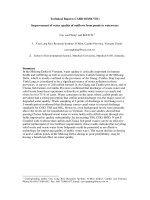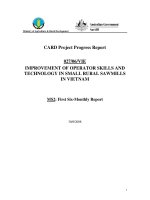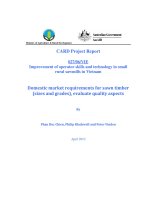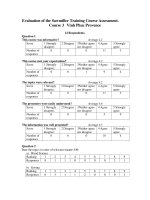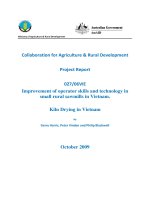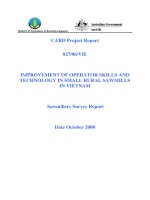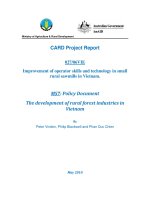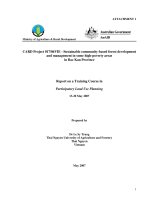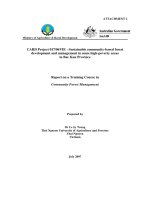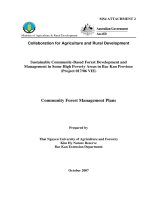Báo cáo khoa học nông nghiệp " RESULTS OF BMP APPLYING TO SHIMP CULTURE IN NORTH CENTRAL VIETNAM " doc
Bạn đang xem bản rút gọn của tài liệu. Xem và tải ngay bản đầy đủ của tài liệu tại đây (108.99 KB, 13 trang )
1
RESULTS OF BMP APPLYING TO SHIMP CULTURE
IN NORTH CENTRAL VIETNAM
Nguyen Xuan Suc
Research Institute for Aquaculture 1
I. INTRODUCTION
Household shrimp production is the predominant form of coastal aquaculture in Vietnam. In
2006, approximately 459,000 tonnes of shrimp was produced comprising 12% of total
fisheries production in Vietnam (USDAFAS 2007). Approximately 34% of shrimp
production (158,000 tonnes) was exported at a value of USD 1.46 billion. Shrimp
production is increasing, with an average of 13% growth experienced each year from 2000
to 2006 (USDAFAS 2007).
In recent years, residues and contaminants have been detected in exported shrimp, with
devastating results in markets. In 2003, five consignments from Thua Thien-Hue province
to the European Union were destroyed or returned because of the presence of residues and a
far larger quantity from all north central provinces were similarly treated in 2004. The loss
of production, negative environmental and socio-economic impacts, and food safety
concerns has provided impetus for the development and extension BMP for shrimp farms.
BMPs have been used in many countries to implement the more general principles of
responsible shrimp farming (FAO 2005). BMPs are voluntary and are becoming widely
used as an important strategy to enhance the marketability of aquaculture product.
A number of projects have contributed to the development of practical BMPs for shrimp
farming in Vietnam (e.g. a DANIDA-funded and a NAFIQAVED). These projects have
proposed specific BMPs and have conducted some small-scale testing of these BMPs. Their
findings have not yet been widely disseminated among producers and BMP implementation
is still limited. The benefits of applying BMP to household farms remain to be fully
investigated. However, experience in Thailand, India and Bangladesh has shown that small-
scale farmers who applied BMPs made gains in efficiency, productivity and quality
(SUMA, 2004).
This report presents the key results of project that “Technical and economic feasibility of
applying the Better Management Practices (BMP) to household aquaculture in Vietnam".
Project focused on BMP applying to shrimp culture of small-scale households in North
Central (include Nghe An, Ha Tinh and Thua Thien Hue provinces). Two main issues
which are presented in this report includes impact of BMP applying to environmental and
economic indicators of shrimp households
II. OBJECTIVES
The overall objective of this project is to investigate the effectiveness of BMP application to
small-scale household farms through reducing negative environmental impacts, increasing
yields, lowering risks and improving product quality - thereby contributing significantly to
long-term poverty alleviation and income generation for households directly involved in
aquaculture production chains.
The short term objectives of the project are: a) to carry out an analysis of current status of
household aquaculture and identify incentives and constraints to BMP application; b) to
develop appropriate BMP guidelines and manuals for household aquaculture in the North
Central region of Vietnam; and c) to build capacity for BMP application among
stakeholders involved in aquaculture product market chains, especially smallholder
producers.
2
III. METHODOLOGY
Baseline study for assessment of BMP status: Standardised surveys and participatory
assessment methods were developed and used for assessing current aquaculture status,
incentives and constraints of farmers to BMP application and draft BMP action plans for
demonstration at household farm level. In each province 30 household farms were sampled.
Data were processed and analysed to serve as the basis for demonstration farm selection and
kept as baseline indicators for comparison with demonstration and control farms during and
after the project implementation.
On farm trials for BMP development: Two types of common farming systems practiced by
household farmers: semi-intensive and improved extensive. In the semi-intensive systems, a
group of 20-30 farms in each province was selected and be encouraged to form an aqua-club
or association for BMP demonstration. BMP practices will be promoted and shared among
group members throughout the project implementation period. Each semi-intensive group,
one household farm was selected to demonstrate BMP application through experiment
treatment. To be considered for selection, household farms need to already conform to some
initial criteria for BMP such as appropriate infrastructure and irrigation systems. In the
improved extensive systems, two groups of 20-30 farms per province were selected and
encouraged to form aqua-clubs or associations and the applying procedure is similar to the
semi-intensive.
BMP protocol for demonstration in the project sites has been developed. These tentatively
include: practices of pond preparation, seed selection and stocking, feed and feeding
management, water quality management, disease management, post-harvest handling and
product control. Post-larvae that are free of white spot disease (WSD) and Monodon
Baculovirus (MBV) are used in trials. Some data (observations of shrimp health, feed tray
clearance, water quality data) were collected daily by farmers using field test kits and
equipment. Farmers were given a farm record book to write all practices, data recordings,
seed, and feed and water inputs he/she applies to the farm. Environmental data (salinity, pH,
DO, BOD, NH3, NO2) were collected and analysed monthly by project staff. Shrimp
product samples were checked for chemicals and antibiotic residues one month before
harvest (with specific analysis for contaminants banned by EU).
Building capacity for BMP implementation: During the project implementation, capacity
of stakeholders for BMP implementation were built through participating in project
meetings, training courses, workshops, cross visits and study tours.
IV. RESULTS AND DISCUSSIONS.
4.1 Environmental Quality of Shrimp Aquaculture Systems
Transparency: It is recommended that transparency remain between 25 and 40 cm for
maximum production (Boyd 1990). If transparency is less than 25 cm and the pond is too
turbid with phytoplankton, this may create problems with dissolved oxygen. If the reading
is greater than 40 cm then the phytoplankton is too scarce. Transparency readings were
found to be above the maximum level at the start of the production period in ponds of all
three provinces, decreasing to within recommended levels half way through the season in
Ha Tinh and Nghe An. While transparency readings were higher than recommended in the
inlets and outlets of all provinces, transparency is considered to be an indication of pond
condition and phytoplankton density, and is therefore less important in the inlet and outlet
channels. Transparency levels in the inlet and outlet are unlikely to have an impact on the
3
environment, or affect food safety, as it is purely an optimal range for the best growth of the
shrimp. Plankton blooms favour greater shrimp production by stimulating the growth of
shrimp food organisms and it also limits the visibility of the shrimp from predatory birds,
thus reducing stress to the target species allowing them to roam and feed, and develop more
quickly.
Salinity: There is very little difference in salinity levels between water sources in any
provinces. It is recommended that for maximum production, salinity levels remain between
15 and 25 % (Boyd 1990). Salinity levels remained between this range in Nghe An, but
increased to 27 % by the end of the cultivation period in Ha Tinh, and dropped below this
range mid-season in Thua Thien-Hue due to heavy rainfall which is common for that time
of year. Salinity levels in the inlet and outlet during and at the end of the trial are unlikely
to have an impact on the environment or food safety. Ha and Suc (2007) indicates a range of
13-24 %o for the three areas prior to stocking.
pH: It is recommended that for maximum shrimp production, pH remain between 7.5 and
8.5 (Boyd 1990). The pH of the culture pond was consistently within this range throughout
the season in all provinces. pH levels were lower than recommended in inlets and outlets in
Nghe An and in the inlets in Ha Tinh, although this does not have an impact on shrimp
production if pH levels are correct within the ponds themselves. pH levels in inlet and outlet
canals during and at the end of the trial is unlikely to have an impact on the environment or
food safety. The baseline data report (Ha and Suc 2007) indicates a range of 6-8.30 for the
three areas prior to stocking.
Dissolved oxygen (DO): Generally, dissolved oxygen levels are highest in the inlets, and
lowest in the outlets. Dissolved oxygen of the culture pond at Ha Tinh and Thua Thien-Hue
sat above 5.5 mg/l (above 5 mg/l being optimal) even though the outlet pond readings did
drop below 4.5 mg/l. At Nghe An, dissolved oxygen dropped below 5 mg/l for most of the
season and ended at around 3.75 mg/l. Despite the dissolved oxygen of the outlet pond in
Ha Tinh dropping to around 2.75 mg/l at the end of the season, the culture pond stayed at a
stable 5.5 mg/l. As shrimp spend most of their time on the pond bottom, the mud/water
interface and its oxygen content is very important. Almost all muds are devoid of oxygen
below a depth of a few centimetres because of poor water circulation and microbial activity
within the mud. Maintenance of oxygenated conditions at the mud surface is particularly
important in shrimp ponds as oxygen is needed for shrimp and food organism respiration, it
promotes microbial degradation of organic matter, and prevents the release of toxic, reduced
substances such as hydrogen sulphide and nitrite (Boyd 1990). If the readings where taken
at the same position each time in the culture ponds it may be that there were other stagnant
areas of the pond, which were not aerated and circulated properly, hence causing an overall
reduction of oxygen in the system. DO at these levels are unlikely to affect food safety,
however DO levels in outlets that fall lower than 5mg/l may have an impact on the
environment, and plants and animals in the surrounding aquatic ecosystem. Under normal
stream conditions 3.0mg/l or less, of DO is regarded as hazardous for a significant variety of
fish fauna (Ellis 1937).
Water temperature: There was little difference in the water temperature between water
sources in any of the provinces. For shrimp production, it is recommended that the
temperature remains between 25 and 33
o
C for maximum production. Temperature remained
within this range in all provinces. Temperature increased over the season in all provinces,
and experienced significant increases mid-season in TT-Hue and Nghe An corresponding to
the drop in salinity and pH of the water.
4
Ammonia (NH
3
): Ammonia levels were consistently low in all water sources and provinces
throughout the season. Levels were below 0.1 mg/l in all sources, which is the maximum
recommended level for Vietnam (internationally, Chin & Chen (1987) consider 0.13 mg/l of
ammonia to be a safe level for shrimp pond conditions). Generally, ammonia levels were
found to be higher in the outlets than in the ponds and inlets. Levels of ammonia in the
outlet channels were not significantly high and would be unlikely to impact the environment
or food safety standards. Ammonia is more toxic when dissolved oxygen concentration is
low, however with increasing carbon dioxide (which occurs when DO is low) the toxicity of
ammonia decreases (Boyd 1990).
Alkalinity: Alkalinity averaged approximately 85 mg/l in all water sources, although it
increased significantly to approximately 100 mg/l in Ha Tinh during the end of the data
collection period. This increase corresponds to a drop in temperature, salinity and pH.
Alkalinity in all water sources generally remained within the safe range of 80-120 mg/l.
Alkalinity is defined as the sum of exchangeable bases reacting to neutralise acid when an
acid is added to water. Alkalinity plays two important roles in water. Bicarbonates, and
carbonates to a lesser degree, are a storehouse of carbon needed in photosynthesis for
phytoplankton growth. They also constitute the major buffering system to reduce
fluctuations in pH. Alkalinity levels in outlets and inlets at all times during the trial was
unlikely to have any impact at all on the environment or affect food safety.
Nitrite: There are significant differences in nitrite levels across provinces and water sources.
It is recommended that nitrite levels remain below 0.30mg/l to maximise shrimp production.
Whilst sub-lethal concentrations of nitrite increases the susceptibility of fish to bacterial
diseases (Hanson & Grizzle 1985), nitrite levels were significantly lower than this level for
all water sources in Thua Thien-Hue, and generally for inlets and ponds in Ha Tinh and
Nghe An. As there are many factors which affect the nitrite toxicity in fish and shrimp
ponds (e.g. chloride concentration, pH, animal size, previous exposure, nutritional status,
infection and dissolved oxygen concentration (Schwedler et al. 1985)), it is difficult to
pinpoint one variable. However, attention to dissolved oxygen is again highlighted as
important.
Sulphides: It is recommended that sulphides remain below 0.2mg/l for maximum
production. Sulphide levels in Thua Thien-Hue were consistently and significantly below
this level for all water sources in Thua Thien-Hue, and for inlets and ponds in Ha Tinh and
Nghe An. Sulphide levels were higher than recommended in the outlets in Nghe An, and in
Ha Tinh at the beginning of the season. Toxic amounts of hydrogen sulphide block the
electron transport system and stops oxidative respiration. Blood lactate concentrations also
increase and anaerobic glycolysis is favoured over aerobic respiration, suggesting that the
toxic effect is hypoxia. Therefore, increased levels of dissolved oxygen are desirable (Boyd,
1990). Hydrogen sulphide toxicity is also more common in acidic environments as pH
decreases. As hydrogen sulphide is toxic at low concentrations and egg survival and fry
development of fish can be limited by 0.006mg/l H
2
S, impact on the environment should be
monitored. If the pond water can be aerated prior to discharge this would minimise the
environmental impact of H
2
S. At the levels reflected in these data food safety is not a
concern.
4.2 Shrimp product quality analysis results
Shrimp product quality samples in crops of 2007 and 2008 were analysed and collected by
officials from Vietnam’s National Fisheries Quality Assurance and Veterinary Directorate
(NAFIQAVED) – the agency which controls food safety and veterinary services for seafood
products. The data includes chemical and microbiological analysis (Table 1). Results
5
indicate non-existent amounts of almost all compounds, except a negligible positive result
for Furazolidone (AOZ) in ponds 8 and 9 in 2007 (Ha Tinh province) and Salmonella in
ponds 2 and 3 (Thua Thien-Hue province in 2007) and pond 1 in Ha Tinh in 2008. While
the Salmonella detected is of most concern, there is little likelihood that it would impact on
the health of the shrimp, nor is it likely to affect food safety or off-side environmental
conditions.
Table 1: Chemical and microbial analysis of shrimp products.
Chemical analysis Microbial analysis
Pond Year
CAP
(µg/kg)
AOZ
(µg/kg)
AMOZ
(µg/kg)
AHD
(ppb)
SEM
(ppb)
TPC E. coli
Salmon-
ella
V. ch
2007
ND ND ND ND ND 5.5*100,000 Neg Neg Neg
TTH1
2008
ND ND ND ND ND 4.7*100,000 Neg Neg Neg
2007
ND ND ND ND ND 6.5*10,000 Neg Pos Neg
TTH2
2008
ND ND ND ND ND 7.1*10,000 Neg Neg Neg
2007
ND ND ND ND ND 6.5*10,000 Neg Pos Neg
TTH3
2008
ND ND ND ND ND 6.2*10,000 Neg Neg Neg
2007
ND ND ND ND ND 2.7*10,000 <10 Neg Neg
NA1
2008
ND ND ND ND ND 2.3*10,000 <10 Neg Neg
2007
ND ND ND ND ND 1.2*100,000 <10 Neg Neg
NA2
2008
ND ND ND ND ND 1.4*100,000 <10 Neg Neg
2007
ND ND ND ND ND 2.9*100,000 <10 Neg Neg
NA3
2008
ND ND ND ND ND 1.8*100,000 <10 Neg Neg
2007
ND ND ND ND ND 4.1*10,000 <10 Neg Neg
HT1
2008
ND ND ND ND ND 5.3*10,000 <10 Pos Neg
2007
ND Pos ND ND ND 3.7*10,000 <10 Neg Neg
HT2
2008
ND ND ND ND ND 4.0*10,000 <10 Neg Neg
2007
ND Pos ND ND ND 4.3*10,000 <10 Neg Neg
HT3
2008
ND ND ND ND ND 3.9*10,000 <10 Neg Neg
Coding: CAP: Chloramphenical; AOZ: Furazolidone; AMOZ: Furaltadone; AHD: Nitrofurantoin; SEM:
Nitrofurazone; TPC: Total plate count; E. coli: Escherichia coli; V. ch: Vibrio cholerae; ND: Not Detected;
Neg: Negative; Pos: Positive; TTH: Thua Thien Hue; NA: Nghe An; HT: Ha Tinh
4.3 Household shrimp production
This sub-section presents the household production results of 3 provinces ( Nghe An,
Ha Tinh and Thua Thien Hue). It is also compared the economic analysis results of 3
household groups that are applied BMP (BMP), non-applied BMP (Non-BMP) and
baseline survey (Baseline)
Shrimp harvesting size and productivity.
The analysis results of shrimp harvesting sizes and productivities are presented in Table 2.
Comparison among provinces, shrimp harvesting size of Nghe An in BMP group was
biggest (23.7 g/shrimp on average) and smallest at Ha Tinh in non-BMP farmers (16.2
g/shrimp). The difference of two these mean was significant (about 32%). Comparison
among groups, the average of harvesting size of BMP group was bigger than two other
6
groups non-BMP and Baseline (20.4 compare to 18.2 and 17.1 g/shrimp). The differences
of shrimp size among groups was not much, however this was a significant effected to total
income because of shrimp prices. Normally, big shrimp size is higher price. For example,
shrimp size at 30 g/individual in Nghe An has price of 100 thousand VND/kg. At the same
time, shrimp size at 25 g/individual has price of 80 thousand VND/kg.
Table 2
. Harvesting size and productivity.
Indicator Province BMP Non-BMP Baseline Average
Nghe An 23.7 17.5 17.3
19.5
Ha Tinh 19.0 16.2 20.5
18.6
TT-Hue 20.4 17.7 17.2
18.4
Harvesting
size
(g/shrimp)
Average 19.7 17.1 18.2
18.3
Nghe An 2,172 1,330 1,470
1,657
Ha Tinh 1,078 904 480
821
TT-Hue 1,483 1,264 1,280
1,342
Productivity
(kg/ha)
Average 1,578 1,166 1,080
1,275
In general, the productivities of shrimp culture in study areas fluctuate between 0.5 to 2.2
tonnes/ha. Nghe And has productivity highest in all 3 groups of BMP, non-BMP and
Baseline which were 2,172; 1,330 and 1,470 kg/ha, respectively. In contrast, productivity
in Ha Tinh province was lowest, fluctuation between 480 and 1,078 kg/ha. The difference
of productivity between highest and lowest show that it was significant difference (about
78%). Comparison among groups of farmers, the average of productivity of BMP was
highest (1,578 kg/ha), follow by non-BMP and Baseline groups (1,166 kg/ha and 1,080
kg/ha, respectively). There was a significant difference of productivities between BMP
with non-BMP and Baseline households, the percentage of differences were 26% and 32%,
respectively. Productivity of shrimp culture is based on many different factors, but two
major factors that were investment rate and disease outbreak.
Pond preparation cost
Table 3 presents the hire labor cost, fertilizers and lime cost during pond preparation. The
hire labor cost of BMP, non-BMP groups were lower than that of Baseline in both values
and percentages, however, the differences were not significant. Comparison among
provinces, the value of hire labors cost of Nghe An province was nearly double higher than
that of Ha Tinh and Thua Thien Hue (4.6 mil. VND compare to 2.8 mil. VND/ha).
However, if comparison of percentage, hire cost of Nghe An was lower than that of Ha
Tinh (6% compare to 8%). It was note that the hire cost of Ha Tinh in Baseline data
occupies 17%, but in Nghe An and TT-Hue were only 3% and 6%, respectively.
Table 3.
Hire labor, fertilizers and lime costs.
Indicator Province BMP Non-BMP Baseline Average
Nghe An 6,510 (6) 4,424 (6) 2,890 (5)
4,608 (6)
Ha Tinh 1,749 (4) 1,707 (4) 5,160 (17)
2,872 (8)
TT-Hue 2,627 (3) 2,734 (5) 3,160 (5)
2,840 (4)
Hire labor cost
(‘000 VND/ha)
Average 3,629 (4) 2,955 (5) 3,740 (7)
3,441 (5)
Nghe An 3,143 (3) 3,652 (6) 1,540 (2)
2,778 (4)
Ha Tinh 1,366 (2) 1,280 (3) 1,340 (4)
1,329 (3)
TT-Hue 2,973 (4) 1,920 (3) 1,140 (2)
2,011 (3)
Fertilizers and
lime cost (‘000
VND/ha)
Average 2,494 (3) 2,284 (4) 1,350 (2)
2,043 (3)
Notice: Numbers in bracket ( ) show % compare to total cost
7
For fertilizer and lime costs, in general, the average of this cost was about 2 mil. VND/ha
and occupies 3% compare to total cost. Comparison between BMP, non-BMP households
with Baseline group, there was a noticeable difference of value this cost (2.5 and 2.3
compare to 1.3 mil. VND/ha). However, comparison of percentage of fertilizers and lime
costs shows not much difference among groups of BMP, non-BMP and Baseline (3%, 4%
and 2%, respectively). And there was also no significant difference among provinces in
term of percentage of fertilizers and lime cost, fluctuation between 2 to 6%.
Shrimp seed and feed costs.
Shrimp seed and feed cost are presented in Table 4. Seed and feed cost, normally, occupy a
biggest cost in shrimp aquaculture. Seed cost, in general, on average, occupies 13% of total
cost and value at 7.8 mil. VND/ha. There was no significant differences of seed cost among
3 groups of BMP, non-BMP and Baseline (12%, 14% and 13%, respectively). The
percentages of seed cost were also not much different between provinces of Nghe An, Ha
Tinh and TT-Hue. Nghe An has the lowest of seed cost (9%), this cost occupies about 15%
in two other provinces
Feed cost was the biggest compare to other costs in shrimp operation. On average, feed
cost occupies 61% of total cost and value at 38 mil. VND/ha. Comparison among groups of
BMP, non-BMP and Baseline, the lowest of percentage of feed cost was in BMP group
(57%). In contrast, in value of seed cost, Nghe An was highest (approximate 44 mil.
VND/ha) and lowest in baseline households (33.7 mil VND/ha). There was a remarkable
difference in seed cost among provinces and fluctuation between 47 and 72% of total cost.
The percentage of feed cost depended on 2 major factors that were feed quality (or price)
and feeding management. In term of over feeding, it was not only over-expenditure but
also results in water pollution.
Table 4.
Shrimp seed and feed cost
Indicator Province BMP Non-BMP Baseline Average
Nghe An 10,102 (9) 7,865 (11) 4,510 (7)
7,492 (9)
Ha Tinh 8,362 (15) 7,066 (15) 4,580 (15)
6,669 (15)
TT-Hue 8,089 (12) 8,958 (15) 9,630 (15)
8,892 (14)
Seed cost
(‘000
VND/ha)
Average 8,851 (12) 7,963 (14) 6,740 (13)
7,851 (13)
Nghe An 59,492 (53) 42,345 (60) 44,500 (72)
35,429 (62)
Ha Tinh 32,082 (59) 28,975 (61) 14,140 (47)
25,066 (58)
TT-Hue 40,238 (58) 36,821 (63) 42,440 (66)
39,833 (62)
Feed cost
(‘000
VND/ha)
Average 43,937 (57) 36,047 (61) 33,690 (65)
37,891 (61)
Notice: Numbers in bracket ( ) show % compare to total cost
Bio-product, chemical, energy and other costs.
Values and percentages of bio-products, chemicals, energies and other costs are showed in
Table 5. On average, cost of bio-product and chemical occupies 7% of total cost and value
at approximately 5 mil. VND/ha. Non-BMP group has highest of this cost (9%), follow by
BMP farmers (7%) and baseline data (5%). There was a significant difference in this cost
of different provinces in both values and percentages. The proportion of bio-products and
chemicals costs of Nghe An, Ha Tinh and TT-Hue were 10%, 8% and 4% of total cost,
respectively. In value, this cost in Nghe An was four times and double higher than that of
Nghe An and TT-Hue, respectively.
8
Energy in shrimp aquaculture in this study were used for two major purposes that were
pump and paddle-wheel operation. Energy that was used to light ponds area was not much.
On average, energy cost was nearly 5 mil. VND/ha and occupies about 7% of total cost.
There was a considerable differences of energies cost in both percentages and values of
BMP, non-BMP and Baseline groups, which were 11%, 3% and 7%; and 9 mil., 2 mil., and
3,7 mil. VND/ha, respectively. Comparison among provinces, energy cost also had
significant differences in both value and percentages (fluctuation between 1 mil. to 13.7
mil. VND/ha and 2% to 13%)
Other costs, on average, occupy 6% of total cost and value at 2.5 mil VND/ha. The
fluctuation of this cost was high in both value and percentages. In value, it was fluctuated
between 0.1 to 5 mil. VND per ha, and highest in TT-Hue of BMP household at 5.4 mil.
VND/ha, and lowest in Ha Tinh of Baseline data at 0.1 mil./ha. In percentages, on average,
it was shared between 2% to 5%. Comparison of average values of other costs, there was a
measurable differences among groups BMP, non-BMP and Baseline which were 4.2 mil.,
2.2 mil., and 0.8 mil. VND/ha.
Table 5.
Bio-product and chemical, energy and other costs
Indicator Province BMP Non-BMP Baseline Average
Nghe An 15,603 (14) 6,671 (10) 3,380 (5)
8,551 (10)
Ha Tinh 2,951 (5) 5,406 (11) 2,030 (7)
3,462 (8)
TT-Hue 1,037 (2) 3,199 (6) 2,890 (4)
2,375 (4)
Bio-product
and chemical
cost (‘000
VND/ha)
Average 6,530 (7) 5,092 (9) 2,780 (5)
4,801 (7)
Nghe An 13,694 (12) 3,230 (5) 4,540 (7)
7,155 (8)
Ha Tinh 4,482 (8) 1,043 (2) 2,820 (9)
2,782 (6)
TT-Hue 8,780 (13) 1,803 (3) 3,670 (6)
4,751 (7)
Energy cost
(‘000
VND/ha)
Average 8,985 (11) 2,026 (3) 3,680 (7)
4,897 (7)
Nghe An 3,704 (3) 2,036 (3) 650 (1)
2,130 (2)
Ha Tinh 3,662 (7) 1,944 (4) 110 (0)
1,905 (4)
TT-Hue 5,393 (8) 2,734 (5) 148 (2)
2,758 (5)
Other costs
(‘000
VND/ha)
Average 4,253 (6) 2,238 (4) 850 (2)
2,447 (4)
Notice: Numbers in bracket ( ) show % compare to total cost
Total income, total cost and benefit
Table 6 presents the results of total cost, total income and benefit of BMP, non-BMP and
Baseline groups in provinces of Nghe An, Ha Tinh and TT-Hue. In this study, on-farm
labors and opportunities costs were not counted in total cost.
For benefit, general average benefit calculating for all groups at all provinces was about 20
mil. VND/ha. The fluctuation of benefit of different provinces in different group was very
high and ranging between 0.6 to 53 mil/ VND/ha. Comparison among groups of BMP,
non-BMP and Baseline, showed there were noticeable differences of benefit. Benefit of
BMP households was around double that of non-BMP and baseline groups (30.8 compared
to 13.8 and 16.4 mil. VND/ha). On average, benefits from shrimp culture in Nghe An, Ha
Tinh and TT-Hue were 32.6, 7.9 and 19.5 mil. VND/ha, respectively. In each province,
fluctuation of benefit among groups was also big (Nghe An between 17.5 and 52.8, Ha
Tinh between 0.6 and 14.4, TT-Hue between 16.4 and 24.3 mil. VND/ha).
For total cost, the general average value of total cost for shrimp culture of study areas was
63 mil. VND/ha. The fluctuation of total cost value was between 30 and 112 mil. VND/ha.
Comparison among groups of BMP, non-BMP and Baseline data shows that there was a
9
considerable significant difference of total cost and average costs were 78.7, 58.6 and 52.7
mil. VND/ha, respectively. Between provinces, the total cost was also much different. On
average, total cost of Nghe An, Ha tinh and TT-Hue were 81.5, 44 and 64 mil. VND/ha,
respectively. The highest value of total cost was occupied in Nghe An of BMP group
which was 112 mil. VND/ha. The smallest total cost value was in Ha Tinh of Baseline data
(30 mil. VND/ha).
For total income from shrimp aquaculture operation, the general average value of total
income reached at 84 mil. VND/ha. There was a big fluctuation of income of provinces
which was between 31 and 165 mil. VND/ha. Comparison among groups, BMP farmers
has highest income from shrimp (109.5 mil. VND/ha), follow by non-BMP and Baseline
groups (72.5 and 69 mil. VND/ha). Comparison among provinces, the total income in
Nghe An was double and 1.5 times higher than that of Ha Tinh and TT-Hue provinces,
respectively. Total income of BMP household in all of 3 provinces was highest compare to
other groups. However, total income of Baseline farms in Nghe An and TT-Hue was
higher than that of non-BMP, but it was contrasted in Ha Tinh province.
Table 6
. Total cost, total income and benefit of shrimp aquaculture
Indicator Province BMP Non-BMP Baseline Average
Nghe An
112,249
70,224
62,010
81,494
Ha Tinh
54,654
47,423
30,180
44,086
TT-Hue
69,137
58,169
64,410
63,905
Total cost
(‘000
VND/ha)
Average
78,680
58,605
52,730
63,338
Nghe An
165,072
87,780
89,480
114,111
Ha Tinh
70,070
55,144
30,740
51,985
TT-Hue
93,429
74,576
82,120
83,375
Total
income
(‘000
VND/ha)
Average
109,524
72,500
69,160
83,728
Nghe An
52,823
17,556
27,480
32,620
Ha Tinh
15,416
7,721
570
7,902
TT-Hue
24,292
16,407
17,720
19,473
Benefit
(‘000
VND/ha)
Average
30,844
13,895
16,430
20,390
Benefit cost ratio.
Benefit cost ratio (BCR) is a very important indicator to assess the effect of shrimp
aquaculture of households. BCR is measured by ratio between total income and total cost.
Table 7 shows the BCR of different households groups (BMP, non-BMP and Baseline) in
different provinces (Nghe An, Ha Tinh and TT-Hue).
In general average of BCR of all provinces was 1.3, it means that shrimp farms invest 1
VND, income 1.3 VND or benefit 0.3 VND. Comparison among groups, the BMP farms
have the highest BCR, which was 1.37 on average, follow by Baseline and non-BMP
groups (1.29 and 1.23, respectively). There was a remarkable significant difference in BCR
among provinces in different groups and fluctuated between 1.02 and 1.47. The highest
BCR was appeared in Nghe An province (1.29 on average) and lowest in Ha Tinh (1.30 on
average)
Table 7.
Benefit cost ratio (BCR)
Province BMP Non-BMP Baseline Average
Nghe An
1.47
1.25
1.44
1.39
Ha Tinh
1.28
1.16
1.02
1.15
TT-Hue
1.35
1.28
1.27
1.30
Average
1.37
1.23
1.29
1.30
10
Comparison of price of seed, feed and shrimp product
The price of input materials and output product is the important factors influent to the
shrimp operation and income of shrimp households. In this sub-section, price of some
major input materials, which were occupied high proportion of total cost (seed, feed), and
shrimp product price were compared among provinces and groups of farmers. Table 8
presents the results of average value of price of seed, feed and shrimp product.
Table 8.
Prices of seed, feed and shrimp product.
Indicator Province BMP Non-BMP Baseline Average
Nghe An 42.0 44.3 35.2
40.5
Ha Tinh 45.2 47.4 53.7
48.8
TT-Hue 135.4 148.3 171.9
151.9
Shrimp price
(VND/shrimp)
Average 74.2 80.0 87.0
80.4
Nghe An 19.0 18.5 14.0
17.2
Ha Tinh 18.5 18.0 12.0
16.2
TT-Hue 18.0 18.0 13.0
16.3
Shrimp feed
price
(‘000
VND/kg)
Average 18.5 18.0 13.0
16.5
Nghe An 76.1 65.7 61.0
67.6
Ha Tinh 65.0 61.1 64.0
63.4
TT-Hue 63.2 59.2 64.0
62.1
Shrimp
product price
(‘000
VND/kg)
Average 68.1 62.0 63.0
64.4
For price of shrimp seed, the general price of shrimp seed of study area was 80
VND/shrimp. There was a not considerable difference in seed price among groups of BMP
and non-BMP and Baseline. The price of seed of Baseline was slightly higher than that of
two other groups (87 compare to 72 and 80 VND/shrimp). It was reality that the price of
shrimp seed in 2007 and 2008 was cheaper than previous years, but the decrease of seed
was not much over time. Comparison among provinces, the shrimp seed price of TT-Hue
province was highest, approximate 3 times higher than that of other provinces. This was
due to the shrimp seed size in TT-Hue was bigger (P45) than that of Nghe An and Ha Tinh
provinces (P15).
For shrimp feed price, the average price of shrimp feed for all provinces of all groups was
16.5 thousand VND/kg. Feed price of baseline data was significant higher than that of
BMP and non-BMP groups, the difference in price was about 5 thousand VND/kg,
equivalent to 28%. The feed price was not much different among provinces. Feed cost
occupies about 61% of total, so the increase of feed price over last 2 years has a negative
impact on shrimp operation and income of shrimp households.
For shrimp harvesting product price, the general average of shrimp product price was 64
thousand VND/kg, one thousand higher compare to Baseline data. The BMP group had the
highest shrimp product price which was 68 thousand VND/kg, and lowest price was at
non-BMP group (62 thousand VND/kg). Normally, the bigger shrimp was sold with higher
price, this was right in this case because the harvesting size of shrimp of BMP was bigger
than that of other groups. The price of shrimp product in different provinces was not
measurable differences, except shrimp product price of BMP farmers in Nghe An was
much higher than that of other provinces. In general, the increase of shrimp product price
was not much compare to baseline data (about 1.5%), however, the feed (main cost)
quickly increased (increase 28%). Therefore, this was a constraint of shrimp operation in
Vietnam, in general and in projects’ areas, in particular.
11
V. CONCLUSIONS
Environmental indicators
• Environmental data reflected ongoing problems with transparency with readings being
over the acceptable maximum level of 40 cm, some also fell below the minimum of 25
cm. If transparency is less than 25 cm and pond is too turbid with phytoplankton this
may create problems with dissolved oxygen. If the reading is greater than 40 cm then
the phytoplankton is too scarce.
• Results correlated with all ponds beginning in the optimal range, ponds in Nghe An and
Ha Tinh rising steadily towards the end of the season and finishing over the optimal
range at 27%. TT-Hue reflected an aberration with a sharp drop mid season to below the
optimal range then rising gradually. Fluctuations in salinity are especially critical when
shrimp moult.
• Low dissolved oxygen was problematic in the early mornings for most ponds. Some
ponds suffered low dissolved oxygen both in morning and afternoon, with
corresponding poor health, growth rates and increased shrimp mortality. Low dissolved
oxygen levels are easily alleviated with aeration; hence it is highly recommended that
effective aeration be put in place for future seasons and used at the applicable times of
the day.
• All areas had temperature fluctuations throughout the season, although it stayed
predominantly within the optimum range for this species. There was a rapid drop in
temperature data in mid April for TT-Hue and early May for Nghe An.
•
Alkalinity was generally within the optimal range for all ponds. Whilst the baseline
survey at the TT-Hue site was the only area to have excessive alkalinity readings, the
post cultivation period showed that the TT-Hue farmers had alkalinity under control;
hence the conditions were better than when they started. Ammonia, nitrate and sulphide
levels stayed within optimal levels.
Economic indicators
•
The average value of total income from shrimp culture of all farms in study area was
approximately 84 mil. VND/ha. There was a significant difference of income from
shrimp culture of BMP, Non-BMP and Baseline groups. The income from shrimp
culture of BMP group was highest, which was nearly double higher than that of
Baseline and 1.5 times higher than that of Non-BMP group. Among provinces, there
was a remarkable difference in income from shrimp culture, Nghe An received a
highest income, which was double higher than that in Ha Tinh and 1.5 times higher
than that of TT-Hue province.
•
The average value of benefit from shrimp aquaculture of all farmers in study area was
20 mil. VND/ha. There was a very difference of benefit from shrimp culture among
farms groups. The benefit value of BMP group was around double higher than that of
Non-BMP and Baseline groups. Among provinces, there was a significant difference in
benefit from aquaculture, benefit value from shrimp culture of Nghe An was 1.7 times
higher than that of TT-Hue and four times higher than that of Ha Tinh province.
•
The average value of total production cost of shrimp culture was 63 mil. VND/ha.
There was a noticeable difference of total cost value among groups and provinces. Total
cost of BMP, Non-BMP and Baseline were 79, 59 and 53 mil. VND/ha, respectively.
Farmers in Nghe An spent highest cost value (81 mil. VND/ha, on average), this values
in Ha Tinh and TT-Hue were 44 mil. VND/ha and 64 mil. VND/ha, respectively.
•
The feed cost was a highest cost of shrimp production, which occupied 61% 0f total
12
cost. There was not a different in percentage of feed cost among farmer groups of BMP,
Non-BMP and Baseline and among provinces. However, there was a significant
difference of feed cost in value among groups and provinces because of different of
investment levels of farm households.
•
Other costs such as seed, fertilizers, hired labors, bio-product, energies etc occupied a
low percentage of total cost, lower than 15%. The difference in percentage of these
costs among farmer groups and provinces was not significant. However, like feed cost,
there was a noticeable difference in value of these costs among farmers groups of BMP,
Non-BMP and Baseline and among provinces of Nghe An, Ha Tinh and TT-Hue.
•
The average value of Benefit Cost Ratio (BCR) of all studied farmers was 1.3. The
BMP farmers group had a highest BCR (1.37) and smallest in Baseline group (1.23).
Nghe An had the highest BCR (1.39) and lowest in Ha Tinh (1.15).
•
Comparison of two input indicators of seed and feed prices and output of shrimp
product price show that the price of feed was quickly increase from 2006 to 2008
(increase 28%). This was a constraint of shrimp aquaculture due to feed cost occupying
61% of production cost in shrimp aquaculture. The price of seed was slightly reduced,
but the rate was very low (about 7%). The price of shrimp product was a slightly
increase, but the increase was very low too (only increase 2%).
REFERRECES
Boyd C. E. (1990) Water Quality in Ponds for Aquaculture. Burmingham Publishing
Company, Burmingham, Alabama.
Chin T. S. & Chen J. C. (1987) Acute Toxicity of Ammonia to Larvae of the Tiger Prawn,
Penaeus monodon. Aquaculture, 66: 247-253.
Ellis, M. M. (1937) Detection and Measurement of Stream Pollution. USA Bureau of Fish.,
Bulletin 22: 367-437.
Fistenet (2007) Fisheries scientific-technical economic information. Fisheries Information
Centre, Vietnam (www.fistenet.gov.vn)
Food and Agriculture Organization (FAO) (2005). Code of Conduct for Responsible
Fisheries. FAO, Rome.
Ha, M.V. and Suc, N.X. (2007) Technical and Economic Feasibility of Applying the Better
Management Practices (BMP) to Household Aquaculture in Vietnam. MS-3 Initial
Environmental Assessment Report. Research Institute for Aquaculture Number 1.
Hanson L.A. & Grizzle J.M. (1985) Nitrite-induced predisposition of channel catfish to
bacterial diseases. Prog. Fish-Culture, 47: 98-101.
Plumb J.A., Grizzle J.M & Defigueiredo, J. (1976) Necrosis and bacterial infection in
channel catfish (Ictalurus punctatus) following hypoxia. Journal Wildlife Diseases, 12: 247-
253.
Schwedler T.E, Tucker C.S. & Baleau M.H. (1985) Non-infectious diseases, p. 497-541. In:
C. S. Tucker (ed.), Channel Catfish Culture. Developments in Aquaculture and Fisheries
Science, Vol. 15, Elsevier, New York.
13
Suc, N.X., Thanh, D. V., Cuong, B.K., Mosk, K.,and Petersen, E.H. (2008) Environmental
and Economic Evaluation of Better Management Practices for Shrimp Culture in Vietnam.
Collaboration for Agriculture and Rural Development 002/05/VIE Working Paper 2.
Suc, N.X., Ha, M.V., Xan, L., Petersen, E.H., Mosk, V., Schilizzi, S. (2009) Technical,
economic, environmental and social indicators analysis of BMP and non-BMP households
in North Center Vietnam. Collaboration for Agriculture and Rural Development 002/05/VIE
Working Paper 3.
Support to Marine and Brackish Aquaculture (SUMA) (2004) Proceedings of Workshop on
Code of Conduct for Responsible Fisheries and Code of Practise/Good Aquaculture Practice
in Vietnam. Hanoi, 5-6 August, 2004. SUMA publication, Hanoi.
Tangko, A.M. & Wardoyo, S.E. (1985) The adaptation of Penaeus monodon Post Larvae to
the Freshwater. Journal Penelitian Busisaya Pantai, 1: 25-32
Thanh, D.V., Suc, N.X, Petersen, E.H., McCartney, A., and Schilizzi, S. (2007) Economic
and Technical Evaluation of Shrimp Culture Management Practices in Northern Vietnam.
Collaboration for Agriculture and Rural Development 002/05/VIE Working Paper 1.
